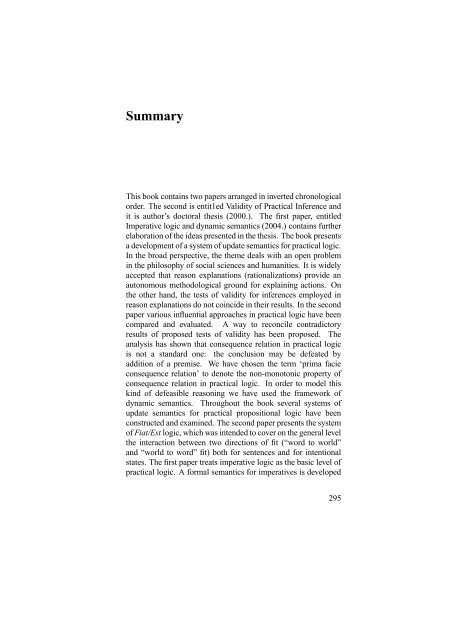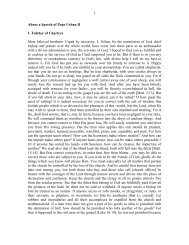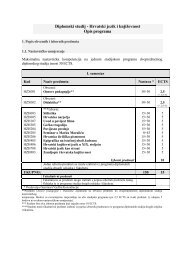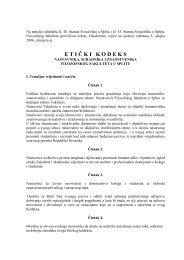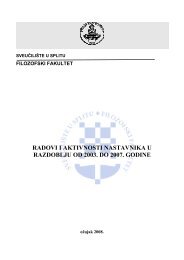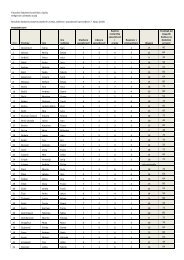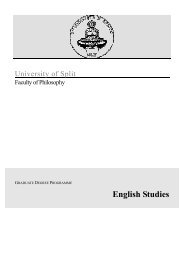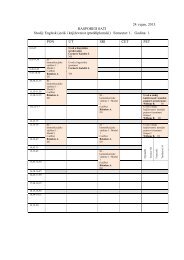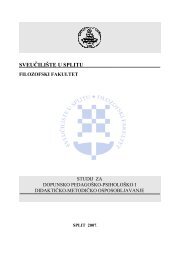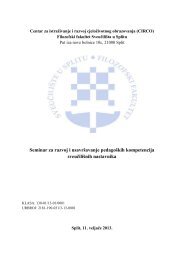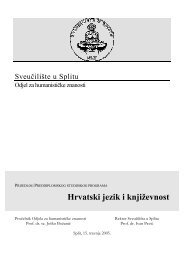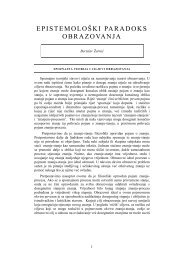- Page 1 and 2:
U PERSPEK- TIVI DINAMIČNE SEMANTIK
- Page 3 and 4:
Strana za odbaciti. 3
- Page 5 and 6:
Sadržaj Zahvale 7 Predgovor 9 IMPE
- Page 7:
Zahvale Mnogima dugujem zahvalnost
- Page 11:
IMPERATIVNA LOGIKA I DINAMIČNA SEM
- Page 14 and 15:
govoreći, tumač na raspolaganju i
- Page 16 and 17:
pq p q - pq p q pq p - pq q - p q -
- Page 18 and 19:
akko Posljedica 0-promjena-provjera
- Page 20 and 21:
0 pq p q - p∨q pq p q pq q - p∨
- Page 22 and 23:
Geach [40] str. 77. Ako slijedimo p
- Page 24 and 25:
24 Modalni element, radikal i seman
- Page 26 and 27:
aspon mogućih aktualnih i budućih
- Page 28 and 29:
Definicija 2.8 Istinitost u situaci
- Page 30 and 31:
Koristeći zapis 5 «s dva radikala
- Page 32 and 33:
Niz rečenica ϕ 1; ...;ϕ n iz jez
- Page 34 and 35:
«Interakcija izme ¯du teorijskog
- Page 36 and 37:
Primjedba 3.1 Dokazi prethodnih lem
- Page 38 and 39:
članova, tj. |D| = n.Tadazasvakiw
- Page 40 and 41:
Budući da wk ∈ S, onda a ∈ S.
- Page 42 and 43:
42 neprihvaćena rečenica, jer ⎡
- Page 44 and 45:
Dokaz. Rutinski uz primjenu tvrdnje
- Page 46 and 47:
Lema 3.6 Neka je s1,...,sn tekst iz
- Page 48 and 49:
stanje hα, γi da vrijedi ili hα,
- Page 50 and 51:
Definicija 3.12 Stanje σ je minima
- Page 52 and 53:
tradikcija. (Slično vrijedi za pre
- Page 54 and 55:
Tvrdnja 3.10 Rečenica ϕ je prihva
- Page 57 and 58:
4 Prima facie posljedica Metafora:
- Page 59 and 60:
(u dijelu jezika pod razmatranjem)
- Page 61 and 62:
Neizvjesnost pruža prirodno stani
- Page 63 and 64:
strane, pojam 0-promjena-provjera p
- Page 65 and 66:
3.1, i tvrdnja 3.3), tj. premise ko
- Page 67 and 68:
prozor’. Ako takva zapovijed ipak
- Page 69:
(i koji time ima istu povijest kao
- Page 72 and 73:
u eliminativnim sustavima obnavljan
- Page 74 and 75:
ϕ Razori Razori ϕ! ϕ! Očuvaj O
- Page 76 and 77:
Definicija 5.4 Stanje hα, γ, πi
- Page 78 and 79:
Definicija5.10(Negacijatvrdnjeoprav
- Page 80 and 81:
Jedan primjer. Primjer 5.1 Formaliz
- Page 82 and 83:
Po ovdje predloženom pristupu mi
- Page 84 and 85:
· σ £ ·ψ →! P ϕ ¤ ½ £ ¤
- Page 86 and 87:
Definicija 6.4 Skup M je skup trenu
- Page 88 and 89:
Definicija 6.15 Akosurečenice ϕ i
- Page 90 and 91:
· hρ, πi[! O ϕ)] = hρ, πi [·
- Page 92 and 93:
Primjer 6.3 ’Pošalji pismo! Ti g
- Page 94 and 95:
Lema 6.2 hProm,Resi [·nf(mem1(mem1
- Page 96 and 97:
cionalnog imperativa sljedeći: ρ
- Page 98 and 99:
Lema 6.5 Dokaz. Rutinski. Instanca
- Page 100 and 101:
disjunkcije bilo valjano, nitko ne
- Page 103:
VALJANOST PRAKTIČNOG ZAKLJUČKA 10
- Page 106 and 107:
azjašnjavanju brojnih značenjskih
- Page 108 and 109:
adekvatno objašnjenje za posebnu n
- Page 110 and 111:
takav pojam o želji kao ciljnom st
- Page 112 and 113:
ulogu u praktičnom zaključivanju
- Page 114 and 115:
nečega. Nikomahova etika, 1139b U
- Page 116 and 117:
nakama dijelimo na izjavne (indikat
- Page 118 and 119:
intencionalnog objašnjenja zahtjev
- Page 120 and 121:
slika mjerene strukture akko R(a1,.
- Page 122 and 123:
nesvjesnim razlozima, ponašanje ko
- Page 124 and 125:
3. postoji trenutak m ∗ koji je i
- Page 126 and 127:
Definicija 2.8 Istinitost stit reč
- Page 128 and 129:
[αdstit: p], M,m1/h1 ² p → q,al
- Page 130 and 131:
Benthem opisuje s dvo-razinskom log
- Page 132 and 133:
· M,s1,s2 ² ϕ? akko s1 = s2 i M,
- Page 134 and 135:
Tablica 1 prikazuje odnose izme ¯d
- Page 136 and 137:
Provjera Izbor σ : hψ?i ϕ σ :
- Page 138 and 139:
Primjer 3.8 Polazeći od tautologij
- Page 140 and 141:
stanjima. Znak ’#’ upućuje na
- Page 142 and 143:
propozicije kako bi opisala učinke
- Page 144 and 145:
· kα∩βk = kαk∩kβk · kα;
- Page 146 and 147:
Ostavljajući usporedbu funkcionaln
- Page 148 and 149:
akko ¬∃y (hx, yi ∈{hx, yi |x v
- Page 150 and 151:
«update-semantici» [79] Kripke mo
- Page 152 and 153:
logikeimodalnelogikejevanEijckovaid
- Page 154 and 155:
∀σ : kϕ 1; ...; ϕ nk σ = σ
- Page 156 and 157:
inkonzistentan (tj. njegovo usvajan
- Page 158 and 159:
na dinamičnu logiku. U ovom počet
- Page 160 and 161:
· Model je par hD, Ii gdje - domen
- Page 162 and 163:
1. (Izvanjski dinamične) promjena-
- Page 164 and 165:
k∃xP (x) → Q(x)k = | {z } b ½
- Page 166 and 167:
kP (c) ∧ Q(x)k = = {hg,hi |∃k :
- Page 168 and 169:
Groenendijk i Stokof koriste samo p
- Page 170 and 171:
kQ(x)kk∃x¬P = (x)kkQ(x)k0 {hh, h
- Page 172 and 173:
je model drugog reda σ = hP, Ri, g
- Page 174 and 175:
Različitost utjecaja pitanja na ko
- Page 176 and 177:
predikatskoj logici. Iz gore navede
- Page 178 and 179:
4. QL slijed τ! ² ϕ! reducira se
- Page 180 and 181:
{hw, vi ∈C | Vw(τ!) = Vv(τ!) =
- Page 182 and 183:
ečenica promjena onda ne postoje n
- Page 184 and 185:
suigračeve ploče možemo zamislit
- Page 186 and 187:
V (ϕ) ∈{>, ⊥}. U filozofijskom
- Page 188 and 189:
eliminaciju svjetova iz S5 modalnog
- Page 190 and 191:
klasičnim su se pristupima rečeni
- Page 192 and 193:
tretiraju propozicije, preciznije
- Page 194 and 195:
sada da se moguće stanje stvari op
- Page 196 and 197:
iječima, relativizacija pokazuje d
- Page 198 and 199:
modusa za svrhe sintakse, a relacij
- Page 200 and 201:
odrediti vrijedi li A i upostaviti
- Page 202 and 203:
Wallace u raspravu uvodi nove termi
- Page 204 and 205:
stanja (tj. obavijesti o toj promje
- Page 206 and 207:
B oblika proglašava valjanim (vidi
- Page 208 and 209:
ostavruju različite oblike logičk
- Page 210 and 211:
0 P O evoluciji modela možemo misl
- Page 212 and 213:
način da je ϕ istinito u svakoj t
- Page 214 and 215:
{p,q} {q} ∅ Model [Est¤(p → q)
- Page 216 and 217:
prihvaćenog cilja. U tipičnom slu
- Page 218 and 219:
· kϕk M ∩ GM 6= ∅ · k¬ϕk M
- Page 220 and 221:
dok GM = {w |∃v : wRv} predstavlj
- Page 222 and 223:
nemaju informacijskog sadržaja jer
- Page 224 and 225:
Motivacijska ekstenzija Fiat(ϕ),..
- Page 226 and 227:
i. ’Fiat’i’Fiat¦’ ii. ’E
- Page 228 and 229:
Definicija 4.20 Model σ verificira
- Page 230 and 231:
⎧ ⎨ [Fiat(ψ)] σ ako [Est(ϕ)]
- Page 232 and 233:
Definicija 4.26 Model σ 0 je minim
- Page 234 and 235:
Rečenica ϕ može imati jednu od s
- Page 236 and 237:
Sada imam dovoljan razlog za biranj
- Page 238 and 239:
Mogući relativni ciljevi mogu post
- Page 240 and 241:
svjetovi postali 1. stanje SC bez i
- Page 242 and 243:
sprihvaćenim pravilnostima. Ta pre
- Page 244 and 245: iti protumačeno kao stanje zadovol
- Page 246 and 247: hP, ∅i nije stanje zadovoljstva j
- Page 248 and 249: modusom to nije slučaj. Tvrdnja 4.
- Page 250 and 251: modalne iskaze u metafizičkom smis
- Page 252 and 253: Baveći se pravilima s iznimkama (
- Page 254 and 255: 4.3.4.1 Zabrane i ciljevi Negaciju
- Page 256 and 257: Sporna je tema odnosa izme ¯du mod
- Page 258 and 259: motivacijskom stanju u kojem je Fia
- Page 260 and 261: pokazuje srodnost s evaluativnim st
- Page 262 and 263: je uslišavanje prijateljičine mol
- Page 264 and 265: 4.3.8 Kriterij valjanosti U prakti
- Page 266 and 267: motivacijske vrste M. Spomenuti uvj
- Page 268 and 269: · 0=hW, W × W i [Fiat(p)] 0 = hW,
- Page 270 and 271: motivacijsko stanje pa do donošenj
- Page 272 and 273: ključak je valjan, u protivnom nev
- Page 274 and 275: svijet eliminiran s test konkluzije
- Page 276 and 277: · Moram se odmoriti. Ako iza ¯dem
- Page 278 and 279: Na toj osnovi autor daje tehničko
- Page 280 and 281: zaključka i objašnjenja pomoću r
- Page 283 and 284: Podaci o radovima Rad Valjanost pra
- Page 285: Visoka učiteljska škola Sveučili
- Page 288 and 289: Philosophy 62(4), str. 85-96., 1965
- Page 290 and 291: Blackwell. Oxford, 1972. [41] Göde
- Page 292 and 293: ence. U: N.Rescher (ured.). The Log
- Page 296 and 297: and checked against some open probl
- Page 298 and 299: 298 171, 173, 174, 178, 180 Groenev


